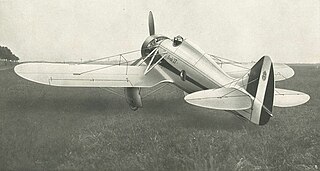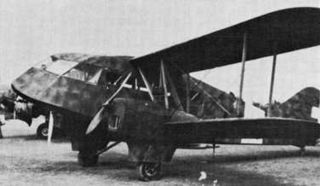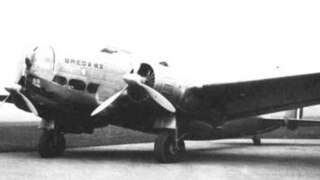
The Aero A.200 was a sportsplane of Czechoslovakia, designed and built specifically to compete in Challenge 1934, the European touring plane championships. It was a four-seater low-wing monoplane.

The Breda Ba.88 Lince was a ground-attack aircraft used by the Italian Regia Aeronautica during World War II. Its streamlined design and retractable undercarriage were advanced for the time, and after its debut in 1937 the aircraft established several world speed records. However, when military equipment was installed on production examples, problems of instability developed and the aeroplane's general performance deteriorated. Eventually its operational career was cut short, and the remaining Ba.88 airframes were used as fixed installations on airfields to mislead enemy reconnaissance. It represented, perhaps, the most remarkable failure of any operational aircraft to see service in World War II.

The Breda Ba.65 was an Italian all-metal single-engine, low-wing monoplane used by Aviazione Legionaria during the Spanish Civil War and Regia Aeronautica in the first half of World War II. It was the only Italian ground-attack aircraft that saw active service in this role. It saw service almost exclusively North African and Middle-Eastern theatre. In addition to more than 150 aircraft operated by the Italian forces, a total of 55 were exported and used by the air forces of Iraq, Chile and Portugal.

The Breda Ba.64 was an Italian single-engine ground-attack aircraft used by the Regia Aeronautica during the 1930s.

The Caproni Ca.314 was an Italian twin-engine monoplane bomber, used in World War II. Derived from the similar Ca.310, it was used for ground-attack and torpedo bomber duties. It was the most extensively built Ca.310 derivative, and included bomber, convoy escort/maritime patrol, torpedo bomber, and ground-attack versions.

PZL.26 was a Polish sports plane built in 1934 in the PZL works. Ordered by the Ministry of Defence, it was specifically designed for the upcoming Challenge 1934 International Touring Aircraft Contest.

The Breda Ba.25 was an Italian two-seat biplane trainer designed and built by the Breda company. It was the most widely used Italian basic trainer of the 1930s.

The Caproni Bergamaschi AP.1 was an Italian monoplane attack aircraft designed by Cesare Pallavicino, coming from the Breda firm.
The Breda Ba.15 was a two-seat light aircraft produced in Italy in 1928.

The Breda Ba.27 was a fighter produced in Italy in the 1930s, used by the Chinese Nationalist Air Force in the Second Sino-Japanese War.

The Breda Ba.44 was a biplane airliner developed in Italy in the mid-1930s and which saw limited military service when impressed into the Regia Aeronautica as transports.

The Caproni Ca.100 was the standard trainer aircraft of the Regia Aeronautica in the 1930s. Large numbers of this tandem, two-seat, biplane were built, powered by different engines.

The Caproni Ca.132 was a prototype for a large aircraft built in Italy in 1934, intended for use as either a bomber or airliner. It was a conventional low-wing cantilever monoplane, powered by a radial engine on each wing and in the nose. The main undercarriage was housed within large streamlined spats. Configured as an airliner, it would have seated 20 passengers.

The Caproni CH.1 was a single-seat biplane fighter, a single example of which was produced as a prototype in Italy in 1935.

The Breda Ba.32 was an Italian airliner prototype designed and built by the Breda company.

The Breda Ba.82 was an Italian medium bomber prototype of the late 1930s; it was designed and built by the Breda company.

The Breda A.14 was a prototype three-engined biplane, designed by Società Italiana Ernesto Breda as a night bomber in 1928. The aircraft was proposed to the Regia Aeronautica, but failed assessments, and was abandoned. The aircraft was designed to solve the flight problems experienced on the A.8. The A.14 was tested in 1928, powered by three 340 kW (450 hp) Alfa Romeo Jupiter engines. Although performance was improved, the Regia Aeronautica decided not to accept the A.14. To make up for the costs, it was suggested that a demilitarised version be sold to civilians, but a lack of civilian interest resulted in the abandonment of the project.
The Breda Ba.46 was a three engined Italian bomber transport, developed from a similar but lower powered civil transport. It was designed in Italy in the mid-1930s for colonial policing but not put into production.

The Savoia-Marchetti SM.80 was a two-seat monoplane amphibian tourer, with a single, tractor engine mounted above the wing, designed in Italy in the early 1930s. The SM.80bis was a four-seat variant, powered by two pusher engines.

























